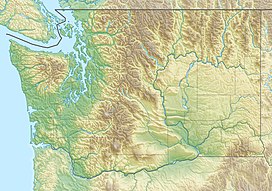| Indian Head Peak | |
|---|---|
 Indian Head Peak from Pacific Crest Trail | |
| Highest point | |
| Elevation | 7,448 ft (2,270 m)[1] |
| Prominence | 2,054 ft (626 m)[1] |
| Parent peak | Kololo Peaks (8,200+ ft)[1] |
| Isolation | 3.92 mi (6.31 km)[1] |
| Coordinates | 48°00′29″N 121°05′52″W / 48.00806°N 121.09778°W[2] |
| Geography | |
 | |
| Interactive map of Indian Head Peak | |
| Country | United States |
| State | Washington |
| County | Chelan |
| Protected area | Glacier Peak Wilderness[2] |
| Parent range | Cascade Range |
| Topo map | USGS Glacier Peak East |
| Geology | |
| Rock age | Late Cretaceous[3] |
| Rock type | Schist[3] |
| Climbing | |
| First ascent | 1870 |
| Easiest route | class 2 scrambling[1] |
Indian Head Peak is a prominent 7,448-foot (2,270-metre) mountain summit located in the Glacier Peak Wilderness, in the North Cascades of Washington state.[4] The mountain is situated in Chelan County, on land managed by the Okanogan–Wenatchee National Forest. Its nearest higher neighbor is Kololo Peaks, 3.29 mi (5.29 km) to the north. Indian Head Peak is the second-highest point on Wenatchee Ridge, a subrange which also includes Mount Saul, Whittier Peak, and Mount David.[2] Precipitation runoff from the peak drains into Indian Creek and White River which are tributaries of the Wenatchee River.
The mountain's name was given by Albert Hale Sylvester (1871–1944), for its resemblance to an "Indian's headdress" when viewed from the south, near Kodak Peak. Sylvester was a pioneer surveyor, explorer, topographer, and forest supervisor in the Cascades. Indian Head Peak was first climbed on July 2, 1870 by railroad surveyors D. C. Linsley and John A. Tennant.[5]
- ^ a b c d e "Indian Head Peak - 7,448' WA". listsofjohn.com. Retrieved 2024-04-07.
- ^ a b c "Indian Head Peak, Washington". Peakbagger.com.
- ^ a b Geologic map of the North Cascade Range, Washington, Haugerud, R.A., and Tabor, R.W., US Geological Survey, 2009.
- ^ "Indian Head Peak". Geographic Names Information System. United States Geological Survey, United States Department of the Interior. Retrieved 2019-04-12.
- ^ Majors, Harry M. (1975). Exploring Washington. Van Winkle Publishing Co. p. 45. ISBN 978-0-918664-00-6.


